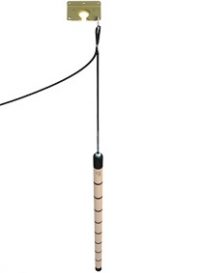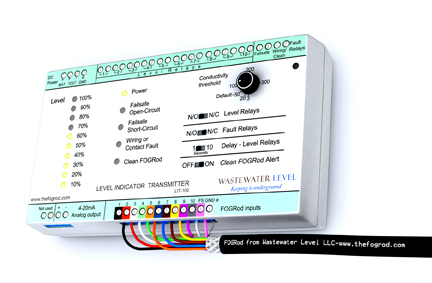FOGRod (Serving Alabama and the Panhandle of Florida) The FOGRod works so well because it is simple – almost as simple as floats, but with much less maintenance; way simpler than ultrasonics; and can’t fail like pressure transducers.
How it Works
The FOGRod hangs in the wastewater and connects to the LIT in the control panel with its 11-core cable. The LIT applies a small voltage to each metal contact on the FOGRod and looks for current flow. When a FOGRod contact is under water, current flows to ground. When a contact is dry, no current flows. It’s like closing a light switch – but in this case wastewater completes the circuit.
LIT
The LIT has 10 relays corresponding to the 10 contacts on the FOGRod. Pick the relays you want to use and wire them into your PLC, your pump controller – or even directly into your starters. If you are replacing floats, just unhook the float wires and connect the LIT relays into the same points. It’s like having 10 floats, but you just pick the ones you want to use.
The LIT also has a 4-20mA output that increases in 1mA steps for each FOGRod contact. So you can replace pressure transducers, ultrasonics and bubblers. If you are replacing floats you can wire the 4-20mA into your telemetry system and get remote level.
The FOGRod has no moving parts, no electronics and no sensors – so there’s nothing in the wetwell to tangle up, get stuck in position, or fail. It is almost as simple as floats.
Cable Breaks
The FOGRod cable has 11 cores but only 10 contacts. One of the cores is a “loopback” test for the top contact. If the cable is broken (e.g., from rats eating the cable) the LIT registers an alarm and activates a fault relay. The same happens if the cable insulation is stripped off in the cable conduit.
- Sorry, this product cannot be purchased.


